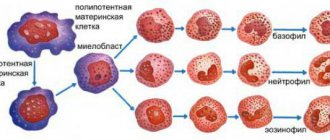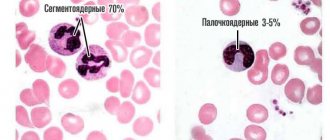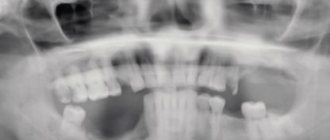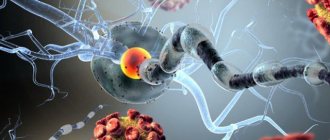Synonyms: neutrophil granulocytes, NEUT, neutrophil segmented granulocytes, polymorphonuclear neutrophils
There are six types of neutrophils depending on the stage of their maturation. Immature types include myeloblasts, promyelocytes, myelocytes, metamyelocytes and band cells. The final stage of development is segmented neutrophils (mature cells with a formed nucleus, divided into several segments).
Even at the stages of their initial development, neutrophils are able to resist infection, although mature segmented cells cope with this task much more effectively.
In blood tests of people suffering from severe infectious diseases, immature forms of neutrophils can be detected. This is explained by the fact that in the fight against pathogenic microorganisms, segmented cells die too quickly, and therefore the body is forced to use cells that are not fully mature. But in the blood of a healthy person, predominantly mature neutrophils are found, since they cope well with their task with virtually no help from their young brothers.
Figure 1. Phagocytosis. Image: mikrostoker/Depositphotos
general information
Neutrophils are a type of granulocytes (granular white blood cells). Their main function is to capture and absorb various harmful particles. Having absorbed microorganisms, they die, and new cells are formed in their place. Together with lymphocytes, they reliably protect the body. Neutrophils are divided into:
- Band cells are blood cells that do not have a formed nucleus. They are also called immature. They are synthesized in the spleen, bone marrow and liver. When maturing, they become mature, i.e. segmented. The function of phagocytosis is carried out by them after full maturation. They live only in the bloodstream, as they are not able to move to the site of the lesion and pass through the wall of the vessel. The norm for an adult is within five percent. In children, this indicator depends on age.
- Segmented - have a clear structure and a formed core.
An individual's immunity is influenced by the number of neutrophils. In addition, the course of inflammatory processes in the body depends on them. Therefore, if the analysis showed that band neutrophils are reduced, then this will negatively affect the health of the individual. However, for a neutrophil to become a full-fledged defender of the body, it must go through several stages of development:
- myeloblast;
- promyelocyte;
- metamyelocyte;
- rod cell - it appears by being ejected when a threat such as pathogens or infection appears;
- A segmented cell is a full-fledged element of blood. It is able to move in the bloodstream.
Functions of band neutrophils
The main functions of immature neutrophils:
- Biological. The cells supply the necessary enzymes to the affected area and thereby activate the process of resorption of necrotic tissue.
- Protective. As a result of phagocytosis, enzyme substances are synthesized, which become an obstacle to dangerous phenomena that threaten the individual’s body.
- They supply antitoxic substances to the blood.
- Participate in fibrinolysis.
It is important to remember that reduced band neutrophils cannot fully perform the necessary functions.
Stages of neutropenia
Neutropenia indicates that the body is tired as a result of a long-term illness and a weakened immune system. Chemotherapy treatment can also provoke this condition. The following stages are distinguished:
- heavy;
- average;
- light.
If the number of band neutrophils is reduced, then the individual experiences weakness, increased sweating, fever, headache, chills and dental problems. The appearance of other symptoms signals the rapid development of the disease and then the patient requires hospitalization and examination. An increased level of band neutrophils indicates the presence of an infection in the body or the development of an inflammatory process.
When is a test ordered?
Band neutrophils can be increased or decreased in patients of different genders and ages.
However, the study is prescribed if there are specific indications in the form of various symptoms and signs of diseases:
- Colds and inflammatory pathologies at the initial stage.
- Increased fatigue and weakness that does not disappear after a long rest.
- Loss of appetite and weight loss for no apparent reason.
- Decreased concentration and memory impairment.
- Dry skin, bleeding gums.
- Indigestion.
- Increased body temperature in the absence of other symptoms of the disease.
- Inflammatory pathologies of the liver, pancreas, gall bladder.
- Kidney diseases in acute and chronic stages.
- Suspicion of acute respiratory tract diseases.
- Oncological diseases in latent form.
- Infectious pathologies of the digestive tract.
- Blood pathologies characterized by a decrease in the level of red blood cells and hemoglobin.
Diagnostics can be prescribed for preventive purposes, which makes it possible to detect abnormalities at the initial stage. This analysis is a standard examination method, therefore, immediately upon admission of a patient to a hospital in any department, blood is drawn and tested. Thanks to the simplicity and speed of diagnostics, it is possible to identify deviations on the day the biomaterial is submitted.
Diagnostics
In order for the doctor to understand why band neutrophils are normal and segmented neutrophils are low, a thorough diagnosis is necessary. The quantitative indicator of immature cells is influenced by various factors. Deviation, both downward and vice versa, signals the development of pathological processes in the individual’s body, which are accompanied by a rather sharp deterioration in his condition. To make a diagnosis, doctors will also be interested in the values of indicators such as:
- leukocytes;
- basophils;
- monocytes;
- eosinophils;
- mature neutrophils.
It is recommended to determine the level of immature cells in the following situations:
- after surgery - to analyze the effectiveness of therapy and wound infection;
- when coughing - an increased amount indicates the bacterial nature of the infection;
- prolonged increase in temperature;
- before prescribing antibacterial medications - in the future this will help determine the effectiveness of therapy (the absence of a decrease in neutrophils will indicate the development of complications);
- the presence of a clinical picture characteristic of acute respiratory infections.
Band neutrophils are reduced: reasons
The main reasons are the suppression of the synthesis of cells belonging to the leukocyte series. In all cases, a decrease in neutrophils and band forms provokes suppression of the immune system and a weakening of the body’s defense response. Among the factors contributing to a slight decrease in these blood cells are:
- age up to five years;
- exhaustion of the body;
- taking certain medications that provoke a decrease in neutrophils - cytostatics, analgesics, anticonvulsants, hormones;
- intoxication;
- allergic reactions;
- being in an unfavorable climatic zone.
Some features of the decrease in band neutrophils
Band neutrophils are immature forms of blood cells. Literally a few hours after their origin, they become mature, i.e. segmented. In infants, normal levels range from five to twelve, and in adults - from one to six percent. Among the reasons for the decrease in band neutrophils in a child are:
- excessive physical activity;
- genetics;
- lack of folic acid and cyanocobalamin;
- hormonal imbalance;
- severe stress;
- lead intoxication;
- radiation;
- bad environment;
- the effect of some drugs.
The following diseases also help reduce them:
- autoimmune diseases;
- bone marrow diseases;
- viral and severe bacterial infections;
- erythremia;
- lymphocytic leukemia in chronic form;
- splenomegaly.
Decoding the leukocyte formula
The leukocyte formula is deciphered using a hemometer. Whether band neutrophils are decreased or, conversely, increased, has important diagnostic significance. If a shift to the left is observed, this indicates the growth of immature cells, and to the right indicates an increase in mature cells. Thus, with a shift to the right, radiation sickness, anemia, kidney and liver disease are suspected. And the presence of a large number of immature cells in the blood is characteristic of malignant tumors and severe inflammatory processes.
When studying a blood test, all indicators are considered. For example, if band neutrophils are reduced, and monocytes and lymphocytes are increased, then this is a sign of an acute infection of viral origin. And if lymphocytes and neutrophils are low or the former are within normal limits, then this indicates the presence of a chronic viral infection. Another interpretation is known - such indicators are temporary and are a consequence of a previous viral infection.
Often, a band neutrophil count of zero indicates an indolent or chronic infection, such as sinusitis or laryngitis. If a zero indicator of band neutrophils is detected, the reason lies in the following:
- viral and bacterial infections;
- anemia;
- exposure to radiation;
- toxic effects of certain drugs.
Indicators of band neutrophils allow the doctor to see how the bone marrow works.
Indications for analysis
A general blood test is the most common hematological test, so the range of indications for its use is wide. Neutrophils are a type of white blood cell whose main task is to destroy pathogenic microorganisms. Therefore, the main goal of the analysis for the content of neutrophils is to identify potentially dangerous conditions accompanied by infectious and inflammatory processes. In other words, a blood test for neutrophils can be informative both for colds and for kidney or liver diseases.
Causes of a low number of neutrophils in an adult
Changes in the level of mature or immature neutrophils are detected when reading a blood test. At the same time, indicators such as monocytes and lymphocytes are compared and analyzed. A sharp decrease in band neutrophils in an adult is present with the following serious anomalies, such as:
- thrombocytopenia;
- metastases in the bone marrow;
- leukemia;
- ulcerative lesions of the stomach and duodenum;
- poisoning;
- consequences of radiation treatment.
Long-term use of penicillin antibiotics, as well as analgesics based on metamizole sodium, helps reduce the level of neutrophils. With low levels of rod and segmented cells, a pregnant woman is at risk of miscarriage. Only a doctor can determine the exact cause of a decrease in any type of neutrophils after additional examination.
Treatment
Intermittent neutropenia usually occurs without symptoms or severe infectious complications, and therefore does not require therapeutic treatment. Especially if the patient carefully observes the rules of personal hygiene, eats foods that have been heat-treated (raw fish dishes, meat with blood are not allowed in case of neutropenia), uses gloves when cleaning, and protects the skin from prolonged exposure to the sun.
With secondary neutropenia, treatment is aimed primarily at eliminating the underlying disease, which led to a pathological decrease in granulocytes.
At the Spizhenko Clinic, treatment of neutropenia is carried out taking into account the cause and clinical symptoms and may include:
- Antibacterial therapy.
- Antifungal therapy.
- Immunotherapy.
- Use of glucocorticoids.
Including treatment of associated conditions (ulcers, stomatitis, gingivitis) by rinsing the mouth with saline solution, using antiseptics (chlorhexidine), nystatin, clotrimazole, fluconazole (for candidiasis).
In case of acute lesions of the mucous membranes, an additional diet (with a predominance of liquid food in the diet) and local anesthesia are prescribed. If the decrease in neutrophils occurred as a result of taking medications, the way out of the situation is to stop using them and switch to alternative treatment.
Medicines
that lead to neutropenia:
- Anticonvulsants (Diazepam, Phenytoin, Sodium Valproate).
- Antidepressants (Clozapine, Haloperidol).
- Antibiotics (Doxycycline, Lincomycin, Cephalosporin, Penicillin, Vancomycin).
- Antiviral (Acyclovir, Zidovudine).
- Anthelmintics (Levomizole, Mebenzadol).
- Antituberculosis (Streptomycin, Rifampicin, Isoniazid, Ethambutol).
- Antifungals (Griseofulvin, Mycozolon, Amorolfine).
Including analgesics (Ibuprofen, Indomethacin, Amidopyrine, Acetylsalicylic acid, Phenylbutazone).
Treatment of febrile neutropenia
Febrile neutropenia requires immediate medical intervention (within 1 hour!).
For neutropenic fever the following is prescribed:
- Antimicrobial therapy;
- Emergency diagnostics (culture of blood, urine, secretions from the mouth, catheterization sites, vagina/urethra, ultrasound of internal organs, radiography).
The basis of modern antibacterial treatment for FN (febrile neutropenia) is beta-lactam antibiotics.
At the Spizhenko Clinic you can undergo a comprehensive study of neutropenia, determine the exact cause and receive the most correct treatment (if necessary).
Neutropenia is not a “sentence”, but also not a reason to leave this situation without competent medical attention.
A child has low band neutrophils: reasons
Acceptable values of mature and immature white cells in the blood of children depend on age. With age, neutrophil counts normalize. However, there are individuals who are diagnosed with chronic neutropenia. When this pathology is diagnosed in a child, he is registered at the dispensary, since low neutrophil counts indicate a failure of the immune system. The baby is constantly attacked by viruses and symptoms such as lethargy, fatigue, low or no mobility appear. Sometimes stomach disorders occur. There are many known reasons that provoke a decrease in immature cells. Significant changes in health indicate the following pathological conditions:
- fungal infections;
- acute leukemia;
- anemia;
- chemical poisoning;
- viral diseases;
- radiation therapy;
- thyrotoxicosis;
- condition after anaphylactic shock.
As in adults, the reason for the decrease in band neutrophils in children is the use of hormones, anticonvulsants, and painkillers. A decrease in neutrophils at an early age is considered a natural process. As they grow older, their number increases. However, a significant decrease in these cells is dangerous and signals low immunity. In addition, low rates may be caused by hereditary factors. In this case, a rather sharp deterioration in well-being and no visible symptoms are observed.
Preparing for analysis
The study is carried out in the morning on an empty stomach, since food intake causes an increase in the number of neutrophils in the blood. Dinner on the eve of the test is allowed no later than eight o'clock in the evening. 2 days before the study, the patient should follow the following preparation rules:
- stop drinking alcohol;
- limit the consumption of spicy, fried and fatty foods;
- Avoid heavy physical activity and nervous stress.
The morning before the test you should not smoke. It is allowed to drink pure still water.
Figure 2. Preparation for donating blood for analysis.
The danger of a low neutrophil count
A decrease signals a severe course of the disease, while the body consumes a large number of immature neutrophils. If the level of band cells is low, neutropenia is diagnosed. For adults, the absence of these cells is less dangerous than for children, since the immune system replaces the missing cells with others.
Deviations from the norm, either in one direction or the other, are dangerous to health. If the level of band neutrophils is reduced, the reason lies in a weakened immune system. In this case, it is necessary to direct all efforts to restore protective forces, otherwise the individual will be constantly susceptible to various serious illnesses.
Interpretation and normal values of the main blood test parameters
| How is it designated? | What does it mean | Norm for women | Norm for men |
| R.B.C. | Red blood cells | 3,5-4,5 | 4,0-5,5 |
| WBC | Leukocytes | 4-9 | |
| PLT | Platelets | 180-320 | |
| HGB | Hemoglobin | 120-140 | 130-170 |
| MCV | Average erythrocyte volume | 82-98 | 81-95 |
| MCH | Average HGB level in erythrocyte | 26-32 | |
| MCHC | Average concentration of red blood cells in HGB (%) | 31-38 | |
| HCT | Hematocrit (in%) | 35-44 | 40-50 |
| RET | Reticulocytes (%) | 0,2-1 | |
| ESR | ESR (mm/h) | 2-15 | 1-10 |
| CPU | Color | 0,85-1,05 | |







